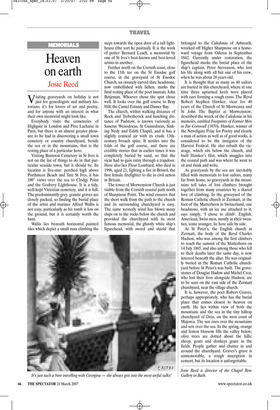Heaven on earth
Josie Reed
Visiting graveyards on holiday is not just for genealogists and military historians; it’s for lovers of art and poetry, and for anyone with an interest in what their own memorial might look like.
Everybody visits the cemeteries of Highgate in London and Père Lachaise in Paris, but there is an almost greater pleasure to be had in discovering a small town cemetery or country churchyard, beside the sea or in the mountains, that is the resting place of a particular hero.
Visiting Barnoon Cemetery in St Ives is not on the list of things to do in that particular seaside town, but it should be. Its location is five-star: perched high above Porthmeor Beach and Tate St Ives, it has 180˚ views over the sea to Clodgy Point and the Godrevy Lighthouse. It is a tidy, well-kept Victorian cemetery, and it is full. The predominantly grey, granite graves are closely packed, so finding the burial place of the artist and mariner Alfred Wallis is not easy, particularly as his tomb is low on the ground, but it is certainly worth the hunt.
Wallis lies beneath horizontal painted tiles which depict a small man climbing the steps towards the open door of a tall lighthouse (the sort he painted). It is the work of potter Bernard Leach, a memorial by one of St Ives’s best-known and best-loved artists to another.
Further north on the Cornish coast, close to the 11th tee on the St Enodoc golf course, in the graveyard of St Enodoc Church, an ornately carved slate headstone, now embellished with lichen, marks the final resting place of the poet laureate John Betjeman. Whoever chose the spot chose well. It looks over the golf course to Bray Hill, the Camel Estuary and Damer Bay.
The church, within walking distance of Rock and Trebetherick and lunching distance of Padstow, is known variously as Sanctus Wenodocus, St Guinedocus, Sinking Nedy and Edith Chapel, and it has a slightly comical air with its crude 13thcentury broach spire. It nestles into the folds of the golf course, and there are credible stories that in earlier times it was completely buried by sand, so that the vicar had to gain entry through a trapdoor. Here also lies Fleur Lombard, who died in 1996, aged 21, fighting a fire in Bristol, the first female firefighter to die in civil action in Britain.
The tower of Morwenstow Church is just visible from the Cornish coastal path north of Sharpnose Point. The wind ensures that the short walk from the path to the church and its surrounding churchyard is easy. The same westerly wind has blown many ships on to the rocks below the church and provided the churchyard with its most famous memorial, the ghostly white ship’s figurehead, with sword and shield that belonged to the Caledonia of Arbroath, wrecked off Higher Sharpnose on a homeward voyage from Odessa in September 1842. Currently under restoration, the figurehead marks the burial place of the ship’s captain, Peter Stevenson, who lost his life along with all but one of his crew, when he was about 28 years old.
It is thought that as many as 40 sailors are buried in this churchyard, where at one time three upturned keels were placed with oars forming a rough cross. The Revd Robert Stephen Hawker, vicar for 40 years of the Church of St Morwenna and St John The Baptist at Morwenstow, described the wreck of the Caledonia in his memoirs, entitled Footprints of Former Men in Far Cornwall (1870). Hawker, winner of the Newdigate Prize for Poetry and clearly a man of action as well as of good works, is considered to be the instigator of the Harvest Festival. He also rebuilt the vicarage, which sits below the church, and built Hawker’s Hut, which snuggles into the coastal path and was where he went to sit and think and write.
As graveyards by the sea are inevitably filled with memorials to lost sailors, many far from home, so graveyards in the mountains tell tales of lost climbers brought together from many countries by a shared love of climbing. In the graveyard of the Roman Catholic church in Zermatt, at the foot of the Matterhorn in Switzerland, one headstone, with an ice axe attached to it, says simply, ‘I chose to climb’. English, American, Swiss men, mostly in their twenties, some younger, lie here side by side.
At St Peter’s, the English church in Zermatt, the body of the Revd Charles Hudson, who was among the first climbers to reach the summit of the Matterhorn on 14 July 1865, and also among those who fell to their deaths later the same day, is now interred beneath the altar. He was originally buried in the Roman Catholic churchyard before St Peter’s was built. The gravestones of Douglas Hadow and Michel Croz, who lost their lives alongside Hudson, are to be seen on the east side of the Zermatt churchyard, near the village church.
It is, however, the poet Robert Graves, perhaps appropriately, who has the burial place that comes closest to heaven on earth. He lies within view of both the mountains and the sea in the tiny hilltop churchyard of Deia, on the west coast of Majorca. The sun rises over the mountains and sets over the sea. In the spring, orange and lemon blossom fills the valley below; olive trees are dotted about the hills; sheep, goats and donkeys graze in the fields. People gather and chatter in and around the churchyard. Graves’s grave is unmemorable, a rough inscription in cement, but its location is unforgettable.


















































































 Previous page
Previous page